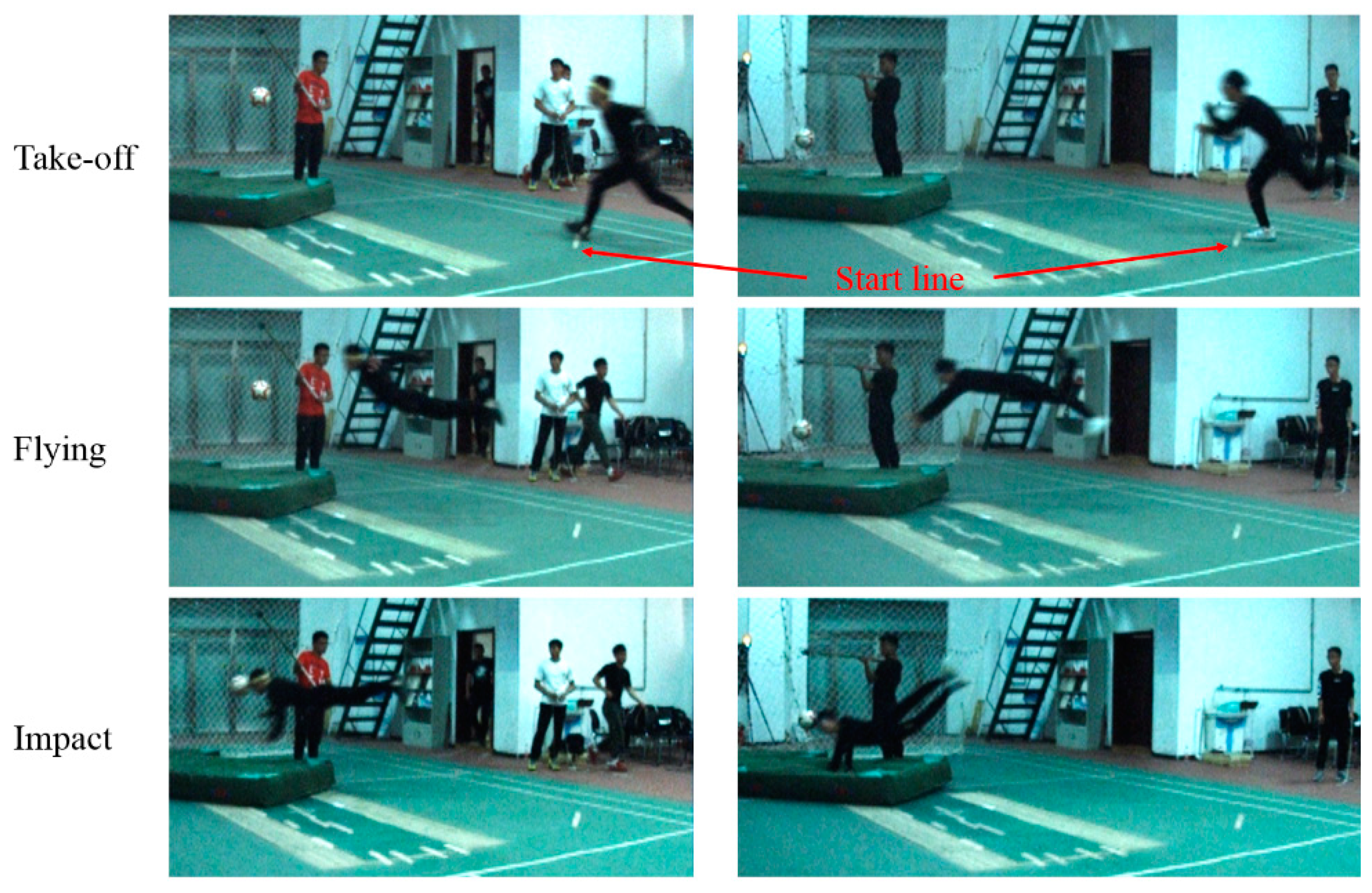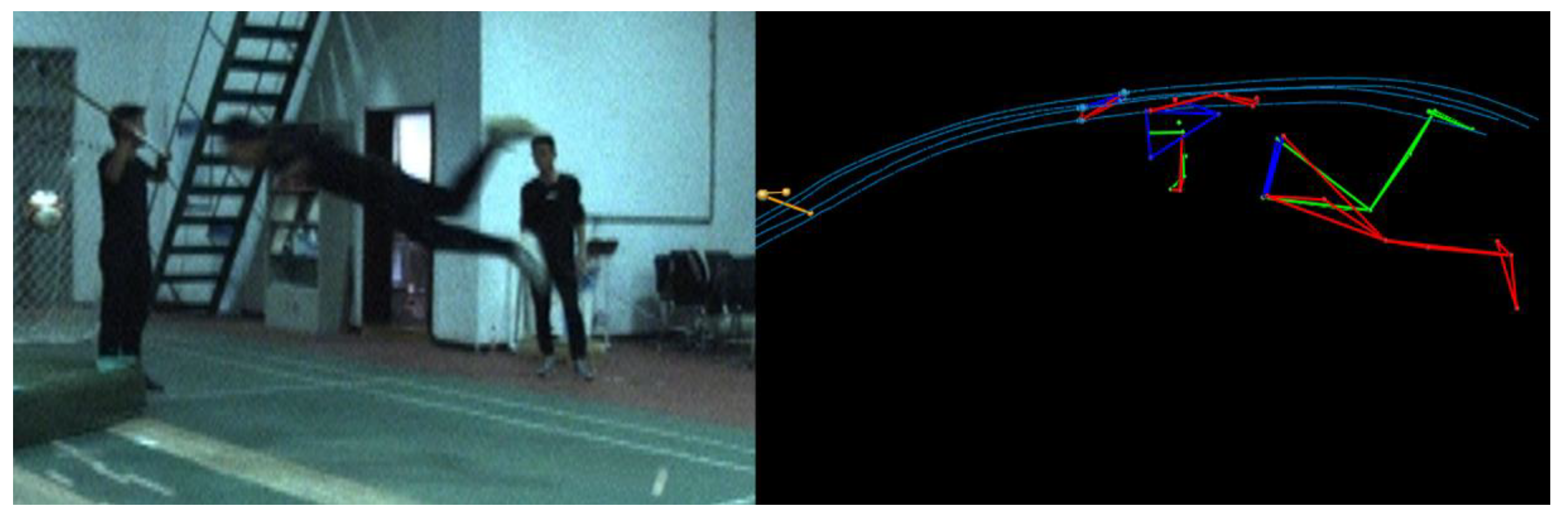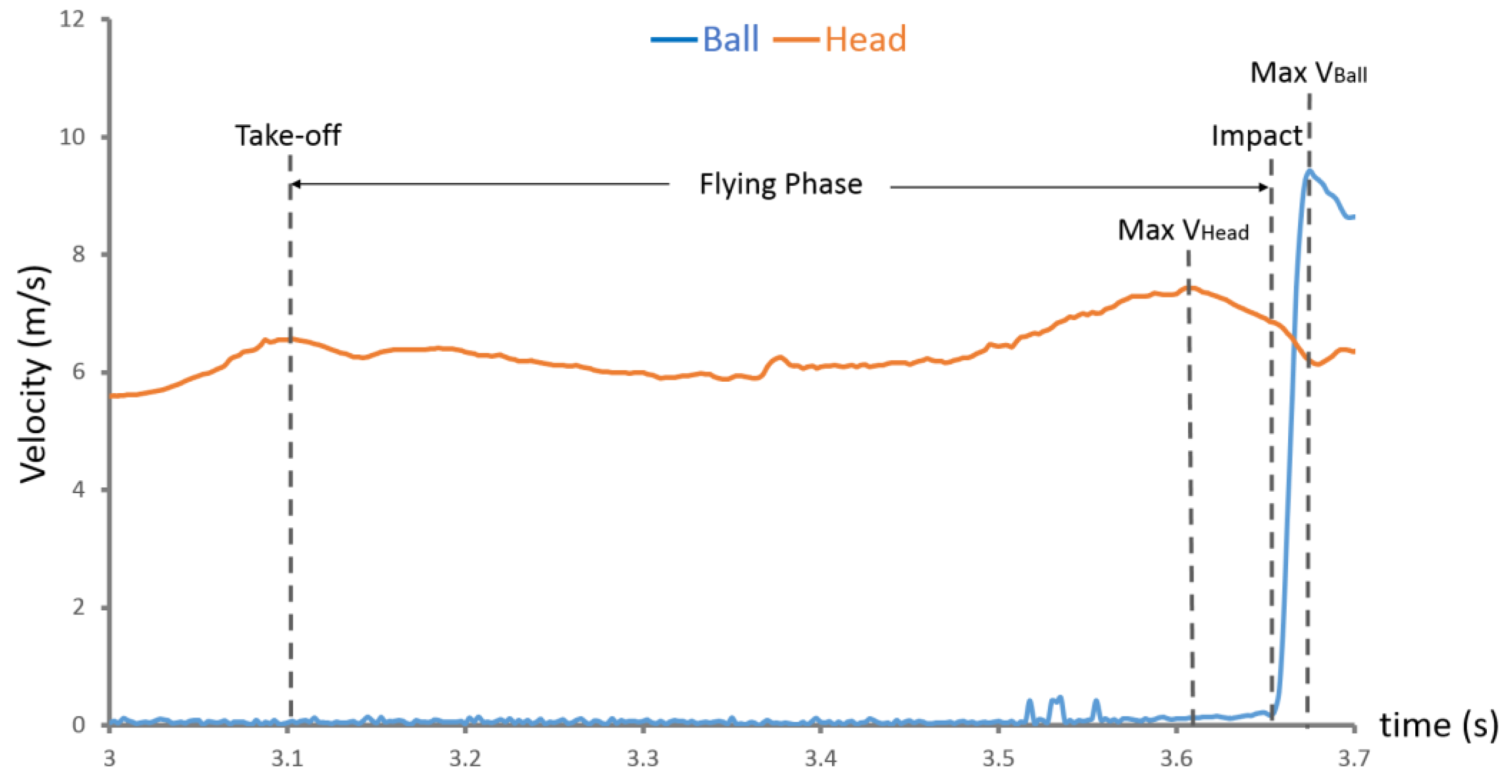Pilot Study on the Biomechanical Quantification of Effective Offensive Range and Ball Speed Enhancement of the Diving Header in Soccer: Insights for Skill Advancement and Application Strategy
Abstract
:1. Introduction
2. Materials and Methods
2.1. Research Design and Test Protocol
- Initially, a static hanging ball was utilized to increase the success rate of diving headers among advanced players;
- A soft gymnastic mat was incorporated to ensure landing protection, aiming to encourage subjects to perform at an airborne level close to elite standards;
- Subsequently, each subject underwent an individualized warm-up routine;
- After the warm-up, each subject executed three maximal standing long jumps to determine their physical strength based on the average jump distance;
- Based on the physical strength assessment and the subject’s body height, three distinct test conditions were established for each subject: (1) short–high ball, where the offensive range was 100% of the maximal standing long jump with the hanging ball positioned at chest level; (2) mid ball, where the offensive range equated to 125% of the maximal standing long jump with the hanging ball positioned at hip level; and (3) long–low ball, where the offensive range exceeded 150% of the maximal standing long jump (tailored according to the subject’s choice) with the hanging ball positioned at knee level (Figure 3);
- Individualized pre-trials were allocated for each subject to familiarize them with the test environment before the 3D data collection;
- Finally, during the 3D data collection, each subject was granted an individualized break (lasting 3–6 min) between trials to ensure high-quality flying performance without the influence of fatigue.
2.2. Participants
2.3. Three-Dimensional Motion Data Collection
2.4. Data Processing and Statistical Analysis
3. Results
4. Discussion
5. Conclusions
Author Contributions
Funding
Institutional Review Board Statement
Informed Consent Statement
Data Availability Statement
Acknowledgments
Conflicts of Interest
References
- FIFA. FIFA Big Count 2006: 270 Million People Active in Football. 2007. Available online: https://digitalhub.fifa.com/m/55621f9fdc8ea7b4/original/mzid0qmguixkcmruvema-pdf.pdf (accessed on 11 November 2022).
- Sawe, B.E. The Most Popular Sports in the World. 2018. Available online: https://www.worldatlas.com/articles/what-are-the-most-popular-sports-in-the-world.html (accessed on 16 June 2018).
- Zhang, X.; Shan, G.; Liu, F.; Yu, Y. Jumping side volley in soccer—A biomechanical preliminary study on the flying kick and its coaching know-how for practitioners. Appl. Sci. 2020, 10, 4785. [Google Scholar] [CrossRef]
- Lees, A.; Nolan, L. The biomechanics of soccer: A review. J. Sports Sci. 1998, 16, 211–234. [Google Scholar] [CrossRef] [PubMed]
- Shan, G.; Visentin, P.; Zhang, X.; Hao, W.; Yu, D. Bicycle kick in soccer: Is the virtuosity systematically entrainable? Sci. Bull. 2015, 60, 819–821. [Google Scholar] [CrossRef]
- Harris, D. Golden Goal: Keith Houchen for Coventry City v Tottenham (1987). 2016. Available online: https://www.theguardian.com/football/blog/2016/may/20/golden-goal-keith-houchen-for-coventry-city-v-tottenham-1987 (accessed on 16 April 2023).
- FIFA. TOP 10 GOALS|2014 FIFA World Cup Brazil. 2015. Available online: https://www.youtube.com/watch?v=c0cUE-ePDEc (accessed on 16 April 2023).
- FIFA. FIFA Puskás Award: Ten Best Goals of the Year Announced. 2014. Available online: http://www.fifa.com//ballon-dor/news/y%3D2014/m%3D11/news%3Dfifa-puskas-award-ten-best-goals-of-the-year-announced-2473885.html (accessed on 16 April 2023).
- Shan, G. Soccer Scoring Techniques: How Much Do We Know Them Biomechanically?—A State-of-the-Art Review. Appl. Sci. 2022, 12, 10886. [Google Scholar] [CrossRef]
- Fluffsta. Keith Houchen 1987 FA Cup Diving Header. 2009. Available online: https://www.youtube.com/watch?v=SNnj6lCui7Y (accessed on 11 April 2023).
- FIFA. Robin van Persie Header—FIFA Puskas Award 2014 FINALIST. 2014. Available online: https://www.youtube.com/watch?v=DeKSmd-hjwo (accessed on 11 April 2023).
- Shan, G.; Zhang, X. Soccer Scoring Techniques—A Biomechanical Re-Conception of Time and Space for Innovations in Soccer Research and Coaching. Bioengineering 2022, 9, 333. [Google Scholar] [CrossRef]
- Shan, G. The Practicality and Effectiveness of Soccer Scoring Techniques Revealed by Top Elite Soccer Scorers. Phys. Act. Rev. 2023, 11, 99–111. [Google Scholar] [CrossRef]
- Mielke, D. Soccer Fundamentals, 1st ed.; Human Kinetics: Champaign, IL, USA, 2003. [Google Scholar]
- Zhang, X.; Shan, G.; Liu, F.; Yong, S.; Meng, M. Diversity of Scoring, Ingenuity of Striking, Art of Flying—Conceptual and Systematical Identification of Soccer Scoring Techniques. Phys. Act. Rev. 2021, 9, 86–99. [Google Scholar] [CrossRef]
- Luxbacher, J.A. Soccer: Steps to Success; Human Kinetics: Champaign, IL, USA, 2013. [Google Scholar]
- Wesson, J. The Science of Soccer, 1st ed.; CRC Press (Taylor & Francis Group): London, UK, 2002. [Google Scholar] [CrossRef]
- Mourão, L.; de Jesus, K.; Roesler, H.; Machado, L.J.; Fernandes, R.J.; Vilas-Boas, J.P.; Vaz, M.A. Effective swimmer’s action during the grab start technique. PLoS ONE 2015, 10, e0123001. [Google Scholar] [CrossRef] [PubMed]
- Blanksby, B.; Nicholson, L.; Elliott, B. Swimming: Biomechanical analysis of the grab, track and handle swimming starts: An intervention study. Sports Biomech. 2002, 1, 11–24. [Google Scholar] [CrossRef] [PubMed]
- Monteiro, R.L.M.; Bedo, B.L.S.; Monteiro, P.H.M.; de Andrade, F.d.S.P.; Moura, F.A.; Cunha, S.A.; Torres, R.d.S.; Memmert, D.; Santiago, P.R.P. Penalty feet positioning rule modification and laterality effect on soccer goalkeepers’ diving kinematics. Sci. Rep. 2022, 12, 18493. [Google Scholar] [CrossRef]
- Ibrahim, R.; Kingma, I.; de Boode, V.; Faber, G.; van Dieën, J. Kinematic and kinetic analysis of the goalkeeper’s diving save in football. J. Sports Sci. 2019, 37, 313–321. [Google Scholar] [CrossRef]
- Wood, R. Standing Long Jump Test (Broad Jump). 2008. Available online: https://www.topendsports.com/testing/tests/longjump.htm (accessed on 16 July 2020).
- Shan, G.; Westerhoff, P. Full-body kinematic characteristics of the maximal instep soccer kick by male soccer players and parameters related to kick quality. Sports Biomech. 2005, 4, 59–72. [Google Scholar] [CrossRef] [PubMed]
- Hamel, J.; Dufour, S.; Fortin, D. Case Study Methods; Sage Publications: Thousand Oaks, CA, USA, 1993. [Google Scholar]
- Bennett, A. Case study methods: Design, use, and comparative advantages. In Models, Numbers, and Cases: Methods for Studying International Relations; Sprinz, D.F., Wolinsky-Nahmias, Y., Eds.; University of Michigan Press: Ann Arbor, MI, USA, 2004; pp. 19–55. [Google Scholar]
- Reilly, T.; Williams, A.M. Science and Soccer; Routledge: London, UK, 2003. [Google Scholar]
- Erdmann, W. Application of biomechanics in soccer training. In Routledge Handbook of Biomechanics and Human Movement Science; Hong, Y., Bartlett, R., Eds.; Routledge: London, UK, 2008; pp. 525–537. [Google Scholar]
- Bekris, E.; Gioldasis, A.; Bekris, V.; Gissis, I.; Komsis, S.; Mitrousis, I. The relationship of kicking ball velocity with anthropometric and physiological factors in soccer. Sport Sci. Rev. 2015, 24, 71–87. [Google Scholar] [CrossRef]
- Lees, A.; Asai, T.; Andersen, T.B.; Nunome, H.; Sterzing, T. The biomechanics of kicking in soccer: A review. J. Sports Sci. 2010, 28, 805–817. [Google Scholar] [CrossRef] [PubMed]
- Bailey, C.A. Quantitative Analysis in Exercise and Sport Science; University of North Texas Libraries: Denton, TX, USA, 2021. [Google Scholar]
- Shan, G.; Bohn, C. Anthropometrical data and coefficients of regression related to gender and race. Appl. Ergon. 2003, 34, 327–337. [Google Scholar] [CrossRef] [PubMed]
- Crowinshield, R.D.; Brand, R.A. The effects of walking velocity and age on hip kinematics and kinetics. Clin. Orthop. Relat. Res. 1978, 132, 140–144. [Google Scholar] [CrossRef]
- Chehab, E.; Andriacchi, T.; Favre, J. Speed, age, sex, and body mass index provide a rigorous basis for comparing the kinematic and kinetic profiles of the lower extremity during walking. J. Biomech. 2017, 58, 11–20. [Google Scholar] [CrossRef] [PubMed]
- Ohji, S.; Aizawa, J.; Hirohata, K.; Ohmi, T.; Mitomo, S.; Jinno, T.; Koga, H.; Yagishita, K. Single-leg hop distance normalized to body height is associated with the return to sports after anterior cruciate ligament reconstruction. J. Exp. Orthop. 2021, 8, 26. [Google Scholar] [CrossRef]
- Levanon, J.; Dapena, J. Comparison of the kinematics of the full-instep and pass kicks in soccer. Med. Sci. Sports Exerc. 1998, 30, 917–927. [Google Scholar]
- Chi, K.-J.; Schmitt, D. Mechanical energy and effective foot mass during impact loading of walking and running. J. Biomech. 2005, 38, 1387–1395. [Google Scholar] [CrossRef]
- Lenetsky, S.; Nates, R.; Brughelli, M.; Harris, N. Is effective mass in combat sports punching above its weight? Hum. Mov. Sci. 2015, 40, 89–97. [Google Scholar] [CrossRef] [PubMed]
- Neto, O.P.; Magini, M.; Saba, M.M. The role of effective mass and hand speed in the performance of kung fu athletes compared with nonpractitioners. J. Appl. Biomech. 2007, 23, 139–148. [Google Scholar] [CrossRef] [PubMed]
- Adamec, J.; Mai, V.; Graw, M.; Schneider, K.; Hempel, J.-M.; Schöpfer, J. Biomechanics and injury risk of a headbutt. Int. J. Leg. Med. 2013, 127, 103–110. [Google Scholar] [CrossRef] [PubMed]
- Babbs, C.F. Biomechanics of heading a soccer ball: Implications for player safety. Sci. World J. 2001, 1, 281–322. [Google Scholar] [CrossRef] [PubMed]
- Shewchenko, N.; Withnall, C.; Keown, M.; Gittens, R.; Dvorak, J. Heading in football. Part 1: Development of biomechanical methods to investigate head response. Br. J. Sports Med. 2005, 39, i10–i25. [Google Scholar] [CrossRef] [PubMed]
- Caccese, J.B.; Kaminski, T.W. Minimizing head acceleration in soccer: A review of the literature. Sports Med. 2016, 46, 1591–1604. [Google Scholar] [CrossRef] [PubMed]
- Shewchenko, N.; Withnall, C.; Keown, M.; Gittens, R.; Dvorak, J. Heading in football. Part 2: Biomechanics of ball heading and head response. Br. J. Sports Med. 2005, 39 (Suppl. 1), i26. [Google Scholar] [CrossRef]
- Spiotta, A.M.; Bartsch, A.J.; Benzel, E.C. Heading in soccer: Dangerous play? Neurosurgery 2012, 70, 1–11. [Google Scholar] [CrossRef]
- Magill, R.; Anderson, D.I. Motor Learning and Control; McGraw-Hill Publishing: New York, NY, USA, 2010. [Google Scholar]
- Dowling, B.; Fleisig, G.S. Kinematic comparison of baseball batting off of a tee among various competition levels. Sports Biomech. 2016, 15, 255–269. [Google Scholar] [CrossRef]
- McCue, M.; Wattie, N. To Tee, Or Not to Tee: Exploring the Relationship between Representative Practice and Performance in Highly Skilled Baseball Hitters. J. Expert. 2021, 4, 19–32. [Google Scholar]





| Parameter | µ ± SD | Normalized by BH |
|---|---|---|
| Max standing long jump (N = 12) | 2.63 ± 0.06 m | 1.54 ± 0.01 |
| EOR (N = 10) | 4.42 ± 0.26 m | 2.64 ± 0.18 |
| BSE (N = 26) | 9.35 ± 1.97 m/s |
| Parameter | Range | r-Value | p | N |
|---|---|---|---|---|
| Flying distance (m) | 2.81–4.73 | 0.08 | 0.43 | 26 |
| Ball height (m) | 0.61–1.41 | 0.21 | 0.31 | 26 |
| Flying time (s) | 0.31–0.65 | −0.03 | 0.54 | 26 |
| µ ± SD | ||||
| Max head speed (m/s) | 7.34 ± 0.45 | 0.37 | 0.05 | 26 |
| Head speed at impact (m/s) | 6.63 ± 0.70 | 0.59 | 0.00 | 26 |
| Head speed drop (%) | 4.93 ±4.27 | −0.77 | 0.00 | 26 |
| Time offset (%) | 26.29 ± 20.56 | −0.67 | 0.00 | 26 |
Disclaimer/Publisher’s Note: The statements, opinions and data contained in all publications are solely those of the individual author(s) and contributor(s) and not of MDPI and/or the editor(s). MDPI and/or the editor(s) disclaim responsibility for any injury to people or property resulting from any ideas, methods, instructions or products referred to in the content. |
© 2024 by the authors. Licensee MDPI, Basel, Switzerland. This article is an open access article distributed under the terms and conditions of the Creative Commons Attribution (CC BY) license (https://creativecommons.org/licenses/by/4.0/).
Share and Cite
Shan, G.; Liu, Y.; Gorges, T.; Zhang, X.; Witte, K. Pilot Study on the Biomechanical Quantification of Effective Offensive Range and Ball Speed Enhancement of the Diving Header in Soccer: Insights for Skill Advancement and Application Strategy. Appl. Sci. 2024, 14, 946. https://doi.org/10.3390/app14020946
Shan G, Liu Y, Gorges T, Zhang X, Witte K. Pilot Study on the Biomechanical Quantification of Effective Offensive Range and Ball Speed Enhancement of the Diving Header in Soccer: Insights for Skill Advancement and Application Strategy. Applied Sciences. 2024; 14(2):946. https://doi.org/10.3390/app14020946
Chicago/Turabian StyleShan, Gongbing, Yufeng Liu, Tom Gorges, Xiang Zhang, and Kerstin Witte. 2024. "Pilot Study on the Biomechanical Quantification of Effective Offensive Range and Ball Speed Enhancement of the Diving Header in Soccer: Insights for Skill Advancement and Application Strategy" Applied Sciences 14, no. 2: 946. https://doi.org/10.3390/app14020946







